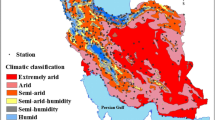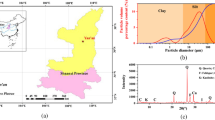Abstract
A frozen soil parameterization coupling of thermal and hydrological processes is used to investigate how frozen soil processes affect water and energy balances in seasonal frozen soil. Simulation results of soil liquid water content and temperature using soil model with and without the inclusion of freezing and thawing processes are evaluated against observations at the Rosemount field station. By comparing the simulated water and heat fluxes of the two cases, the role of phase change processes in the water and energy balances is analyzed. Soil freezing induces upward water flow towards the freezing front and increases soil water content in the upper soil layer. In particular, soil ice obviously prevents and delays the infiltration during rain at Rosemount. In addition, soil freezing/thawing processes alter the partitioning of surface energy fluxes and lead the soil to release more sensible heat into the atmosphere during freezing periods.
Similar content being viewed by others
References
Boone, A., V. Masson, T. Meyers, and J. Noilhan, 2000: The influence of the inclusion of soil freezing on simulation by a soil-atmosphere-transfer scheme. J. Appl. Meteor., 9, 1544–1569.
Cherkauer, K. A., and D. P. Lettenmaier, 1999: Hydrologic effects of frozen soils in the upper Mississippi River basin. J. Geophys. Res., 104, 19599–19610.
Clapp, R. B., and G. M. Hornberger, 1978: Empirical equations for some soil hydraulic properties. Water Resource Research, 14(4), 601–604.
Farouki, O. T., 1981: The thermal properties of soil in cold regions. Cold Regions Science and Technology, 5, 67–75.
Farouki, O. T., 1986: Thermal Properties of Soils. Series on rock and soil mechanics, Vol. ll., Trans Tech Publications, 136pp.
Flerchinger, G. N., and K. E. Saxton, 1989: Simultaneous heat and water model of a freezing snow-residue-soil system: I. Theory and development. Transactions of American Society of Agricultural Engineers, 32(2), 565–571.
Gao, R., Z. G. Wei, and W. J. Dong, 2005: Impacts of the anomalous thawing of the frozen soil in Tibetan Plateau on the summer precipitation in China and its mechanism. Adv. Atmos. Sci., 22(2), 238–245.
Hansson, K., J. Simunek, M. Mizoguchi, L. C. Lundin, and M. T. van Genuchten, 2004: Water flow and heat transport in frozen soil: Numerical solution and freeze/thaw applications. Vadose Zone Journal, 3, 693–704.
Harlan, R. L., 1973: Analysis of coupled heat-fluid transport in partially frozen soil. Water Resource Research, 9, 1314–1323.
Jame, Y. W., and D. I. Norum, 1980: Heat and mass transfer in a freezing unsaturated porous medium. Water Resource Research, 117, 811–819.
Johanson, O., 1975: Thermal conductivity of soils. Ph. D. dissertation, University of Trondheim, 236pp.
Luo, L. F., and Coauthors, 2003: Effects of frozen soil on soil temperature, spring infiltration, and runoff: Results from the PILPS 2 (d) experiment at Valdai, Russia. J. Hydrometeor., 4, 334–351.
Mölders, N., U. Haferkorn, J. Döring, and G. Kramm, 2003: Long-term numerical investigations on the water budget quantities predicted by the hydrothermodynamic soil vegetation scheme (HTSVS)-Part I: Description of the model and impact of longwave radiation, roots, snow, and soil frost. Meteorol. Atmos. Phys., 84, 115–135.
Peixoto, J., and A. H. Oort, 1992: Physics of Climate. American Institute of Physics, 200pp.
Peters-Lidard, C. D., E. Blackburn, X. Liang, and E. F. Wood, 1998: The effect of soil thermal conductivity Parameterization on surface energy fluxes and temperature. J. Atmos. Sci., 55, 1209–1224.
Poutou, E., G. Krinner, C. Genthon, and N. de Noblet-Ducoudréa, 2004: Role of soil freezing in future boreal climate change. Climate Dyn., 23(6), 621–639.
Romanovsky, V. E., and T. E. Osterkamp, 2000: Effects of unfrozen water on heat and mass transportprocesses in the active layer and permafrost. Permafrost and Periglacial Processes, 11, 219–239.
Sellers, P. J., M. D. Heiser, and F. G. Hall, 1992: Relations between surface conductance and spectral vegetation indices at intermediate (100 m2 to 15 km2) length scales. J. Geophys. Rev., 97(D17), 19033–19059.
Shoop, S. A., and S. R. Bigl, 1997: Moisture migration during freeze and thaw of unsaturated soils: modeling and large scale experiments. Cold Regions Science and Technology, 25(1), 33–45.
Williams, P. J., 1967: Properties and behaviors of freezing soils. Norwegian Geotechnical Institute, Publication, No. 72, 119pp.
Yang, Z. L., R. E. Dickinson, A, Robock, and K. Y. Vinnikov, 1997: Validation of the Snow subModel of the biosphere-atmosphere transfer scheme with russian snow cover and meteorological observational data. J. Climate, 10, 353–373.
Zhang, X., S. F. Sun, and Y. K. Xue, 2007: Development and testing of a frozen soil parameterization for the cold region study. J. Hydrometeor., 8(4), 690–701.
Author information
Authors and Affiliations
Corresponding author
Rights and permissions
About this article
Cite this article
Zhang, X., Sun, S. The impact of soil freezing/thawing processes on water and energy balances. Adv. Atmos. Sci. 28, 169–177 (2011). https://doi.org/10.1007/s00376-010-9206-0
Received:
Revised:
Published:
Issue Date:
DOI: https://doi.org/10.1007/s00376-010-9206-0




